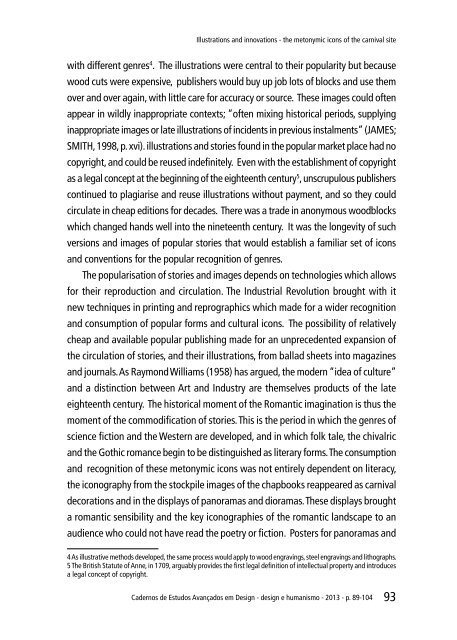o_19po8js951tvs1r0t1r8s4bb1vpla.pdf
You also want an ePaper? Increase the reach of your titles
YUMPU automatically turns print PDFs into web optimized ePapers that Google loves.
Illustrations and innovations - the metonymic icons of the carnival site<br />
with different genres 4 . The illustrations were central to their popularity but because<br />
wood cuts were expensive, publishers would buy up job lots of blocks and use them<br />
over and over again, with little care for accuracy or source. These images could often<br />
appear in wildly inappropriate contexts; “often mixing historical periods, supplying<br />
inappropriate images or late illustrations of incidents in previous instalments” (JAMES;<br />
SMITH, 1998, p. xvi). illustrations and stories found in the popular market place had no<br />
copyright, and could be reused indefinitely. Even with the establishment of copyright<br />
as a legal concept at the beginning of the eighteenth century 5 , unscrupulous publishers<br />
continued to plagiarise and reuse illustrations without payment, and so they could<br />
circulate in cheap editions for decades. There was a trade in anonymous woodblocks<br />
which changed hands well into the nineteenth century. It was the longevity of such<br />
versions and images of popular stories that would establish a familiar set of icons<br />
and conventions for the popular recognition of genres.<br />
The popularisation of stories and images depends on technologies which allows<br />
for their reproduction and circulation. The Industrial Revolution brought with it<br />
new techniques in printing and reprographics which made for a wider recognition<br />
and consumption of popular forms and cultural icons. The possibility of relatively<br />
cheap and available popular publishing made for an unprecedented expansion of<br />
the circulation of stories, and their illustrations, from ballad sheets into magazines<br />
and journals. As Raymond Williams (1958) has argued, the modern “idea of culture”<br />
and a distinction between Art and Industry are themselves products of the late<br />
eighteenth century. The historical moment of the Romantic imagination is thus the<br />
moment of the commodification of stories. This is the period in which the genres of<br />
science fiction and the Western are developed, and in which folk tale, the chivalric<br />
and the Gothic romance begin to be distinguished as literary forms. The consumption<br />
and recognition of these metonymic icons was not entirely dependent on literacy,<br />
the iconography from the stockpile images of the chapbooks reappeared as carnival<br />
decorations and in the displays of panoramas and dioramas. These displays brought<br />
a romantic sensibility and the key iconographies of the romantic landscape to an<br />
audience who could not have read the poetry or fiction. Posters for panoramas and<br />
4 As illustrative methods developed, the same process would apply to wood engravings, steel engravings and lithographs.<br />
5 The British Statute of Anne, in 1709, arguably provides the first legal definition of intellectual property and introduces<br />
a legal concept of copyright.<br />
Cadernos de Estudos Avançados em Design - design e humanismo - 2013 - p. 89-104<br />
93



